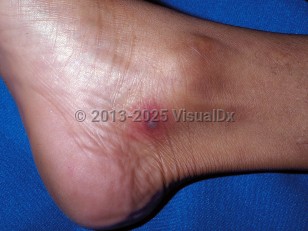Disseminated gonorrhea in Adult
Alerts and Notices
Important News & Links
Synopsis

Gonococcemia (also called arthritis-dermatosis syndrome) refers to the presence of Neisseria gonorrhoeae in the bloodstream, often leading to disseminated gonococcal infection. Gonorrhea, caused by N gonorrhoeae, a gram-negative diplococcus, is the second most commonly reported sexually transmitted infection (STI) in the United States, after chlamydia. Gonococcemia occurs in approximately 1%-3% of patients with gonorrhea.
Disseminated gonococcal infection occurs more commonly in women, due to their higher incidence of occult infection. Recent menstruation and pregnancy are risk factors for gonococcemia. Other risk factors include the presence of HIV, lupus, or complement deficiencies; multiple sexual partners; low socioeconomic status; drug use; men who have sex with men (MSM); and a prior history of STIs. Gonococcemia is most prevalent in the adolescent and young adult populations.
The onset of gonococcemia is often abrupt with fever (usually 101°-104°F [38.3°-40°C]), skin lesions, and arthralgias and/or tenosynovitis. Successive crops of pustules on a purpuric base, papules, petechiae, or areas of necrosis may appear during febrile episodes. Arthralgias are asymmetric and migratory, involving at first the extensor tendons of wrists, fingers, knees, and ankles. Later, septic arthritis leads to pain and swelling in one or occasionally more joints.
Septic arthritis may result in progressive joint destruction and osteomyelitis. Other complications include myocarditis, toxic hepatitis, and, less commonly, endocarditis and meningitis. The mortality of endocarditis remains as high as 19% due to congestive heart failure, nephritis, large vegetations, and aortic involvement. Major embolic phenomena may occur.
Abdominal spread of gonococci may cause gonococcal perihepatitis (Fitz-Hugh-Curtis syndrome) with abdominal pain, tenderness, and, occasionally, a hepatic friction rub. Pharyngitis, acute salpingitis, sterility, pelvic peritonitis, and pelvic abscesses may complicate gonorrhea in women. Men uncommonly develop epididymitis, inguinal lymphadenitis, penile edema, periurethral abscesses, and gonococcal prostatitis. Men who have sex with men (MSM) may develop proctitis, rectal discharge, and pharyngitis.
Disseminated gonococcal infection occurs more commonly in women, due to their higher incidence of occult infection. Recent menstruation and pregnancy are risk factors for gonococcemia. Other risk factors include the presence of HIV, lupus, or complement deficiencies; multiple sexual partners; low socioeconomic status; drug use; men who have sex with men (MSM); and a prior history of STIs. Gonococcemia is most prevalent in the adolescent and young adult populations.
The onset of gonococcemia is often abrupt with fever (usually 101°-104°F [38.3°-40°C]), skin lesions, and arthralgias and/or tenosynovitis. Successive crops of pustules on a purpuric base, papules, petechiae, or areas of necrosis may appear during febrile episodes. Arthralgias are asymmetric and migratory, involving at first the extensor tendons of wrists, fingers, knees, and ankles. Later, septic arthritis leads to pain and swelling in one or occasionally more joints.
Septic arthritis may result in progressive joint destruction and osteomyelitis. Other complications include myocarditis, toxic hepatitis, and, less commonly, endocarditis and meningitis. The mortality of endocarditis remains as high as 19% due to congestive heart failure, nephritis, large vegetations, and aortic involvement. Major embolic phenomena may occur.
Abdominal spread of gonococci may cause gonococcal perihepatitis (Fitz-Hugh-Curtis syndrome) with abdominal pain, tenderness, and, occasionally, a hepatic friction rub. Pharyngitis, acute salpingitis, sterility, pelvic peritonitis, and pelvic abscesses may complicate gonorrhea in women. Men uncommonly develop epididymitis, inguinal lymphadenitis, penile edema, periurethral abscesses, and gonococcal prostatitis. Men who have sex with men (MSM) may develop proctitis, rectal discharge, and pharyngitis.
Codes
ICD10CM:
A54.86 – Gonococcal sepsis
SNOMEDCT:
5085001 – Gonococcemia
A54.86 – Gonococcal sepsis
SNOMEDCT:
5085001 – Gonococcemia
Look For
Subscription Required
Diagnostic Pearls
Subscription Required
Differential Diagnosis & Pitfalls

To perform a comparison, select diagnoses from the classic differential
Subscription Required
Best Tests
Subscription Required
Management Pearls
Subscription Required
Therapy
Subscription Required
References
Subscription Required
Last Reviewed:09/12/2021
Last Updated:10/21/2021
Last Updated:10/21/2021
Disseminated gonorrhea in Adult

